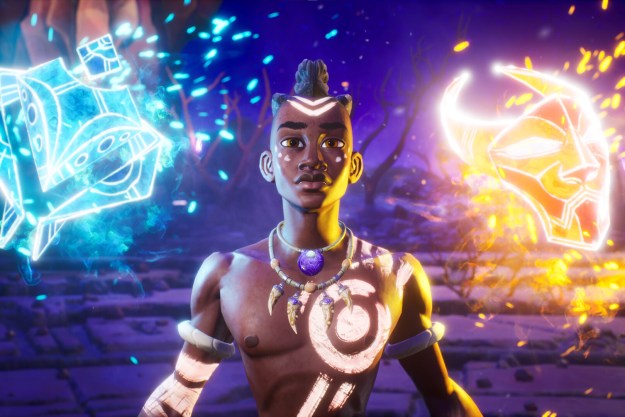
Fuse has such an apt title. The first non-PlayStation exclusive console release from Insomniac Games feels like it’s a fusion of the studio’s two most well-known franchises: Resistance and Ratchet & Clank. You’ve got wacky weapons, colorful characters, an equal focus on delivering compelling co-op and solo play experiences, and a sci-fi universe that toes its way carefully between gritty, hard-edged fiction and light-hearted fun. It feels like a fitting current-gen swansong from a studio that has grown and evolved significantly over the past decade-plus.

Digital Trends got to sit with studio founder and CEO Ted Price at 2013’s Game Developer’s Conference for a final hands-on look at Fuse before it ships to stores on May 28. The demo in question showed off a new section of the game, in which the starring Overstrike 9 squad is sent off to a secret research facility overseen by a brutish Eastern European named Slovenko. It seems that Slovenko is working closely with the Raven organization – Fuse‘s primary antagonist – as he performs experiments using the game’s titular substance. It quickly becomes clear during the level that fusing… err… FUSE with human DNA is… not good.
The level is typical of what we’ve seen from the game so far, which is to say that it’s a series of arenas connected by corridors. Each battle space presents a fresh array of tactical opportunities, including turrets, flanking routes, and ambush opportunities. The setup might sound rote, but the play is quite the opposite. Insomniac managed to nail a great balance between the different characters and what they can do. In fact, Price tells us that this was one of the biggest challenges during development, and one of the key reasons that the game announced years ago – as Overstrike at the time – took so long to bring together.
“Despite the fact that a lot of us still play by ourselves in a dark room, a lot of us also like to play with friends. Over this generation I think this trend has been accelerating.”
“Then, on top of that, making sure these character archetypes that we were developing – Dalton as the tank, Izzy as the healer/crowd-controller, Nya as the AoE/stealth specialist, and Jacob as the distant damage dealer [and] trap expert – getting those archetypes right so that they were clearly communicated by the weapons that you pick up early was hard.”
Each character’s Fuse weapon brings a unique quantity to the battlefield. Dalton’s energy shield blocks incoming fire while active, though it can also be unleashed as a devastating short-to-mid-range melee attack that insta-kills all but the hardiest of foes. It’s a force to be reckoned with on its own, but when you then combine it with Izzy’s Shattergun – which effectively freezes enemies in place with sustained fire – you can literally shatter a crowd in a matter of moments, and net yourself a nice XP combo boost in the process. As fleshed out and complex as the universe of Fuse is, it’s actually the cooperative focus that game first for Insomniac.

Four characters together actually gives us a lot more flexibility in terms of designing believable spaces…”
It’s easy to look at Fuse as a potential testbed for Insomniac as the next generation of hardware arrives, but Price sees the game’s enhancements over previous efforts from the studio as more of an evolution of overall philosophy, particularly with regards to co-op play. Fuse offers four-player, drop-in/drop-out co-op, a feature that we’ve seen more and more over the course of the generation, though it is still a relative rarity. It’s something that is changing, but slowly.

Four always seems to be the magic number in co-op scenarios. Look at Borderlands, look at Call of Duty’s zombie mode, look at Gears of War, look at (the admittedly troubled) Aliens: Colonial Marines. It’s rare that you see more than four players on a co-op battlefield. Gears goes up to five in Horde, but ratchets the number down to four in the campaign. Insomniac is one of the rare studios to have experimented with significantly larger numbers for co-op: Resistance 2 supported eight in a separate mode. Important lessons were learned from that experience.

“With Resistance 2… we had to build the levels in a very different fashion because the amount of space necessary for eight players is pretty significant. We found that it was difficult to make indoor areas in Resistance 2 feel believable. Four characters together actually gives us a lot more flexibility in terms of designing believable spaces, in terms of door sizes and window sizes. It’s funny how much that matters when you as a player are playing through, but it’s those subtle cues that are really important in creating that sense of immersion. If you have to make all of your doorways crazy wide to accommodate eight players, it throws off that sense of scale that we all take for granted in most of these games.”
“The other thing that we felt was important was the sense of quick communication. In a game like this where every character has a different role to play, with four players in a high action game, it felt like the right mix. I could easily communicate with three other people and tell them what I’m doing. If I communicate with seven other people and we’re dealing with seven different archetypes, things can get chaotic much more quickly.”


